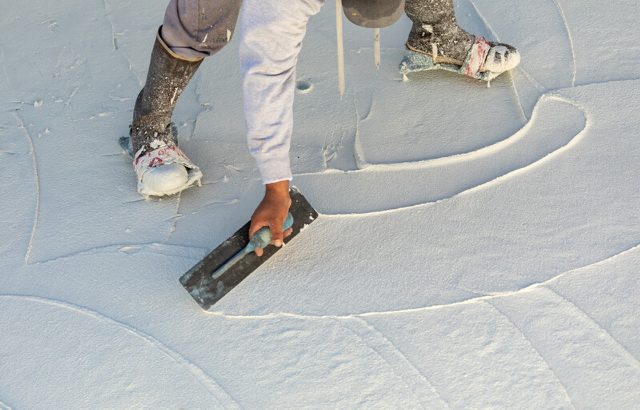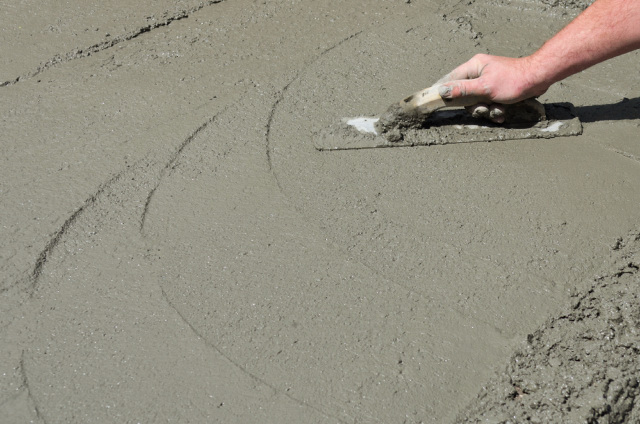So perhaps you’ve recently used your pool and noticed that some white blotches or spots have appeared on your new pool plaster. In this article, I’ll describe exactly what these spots look like, what causes them, where you may see them, and how to fix the issue.
White or gray spots and blotches on a pool’s plaster are often caused by improper plastering practices, incorrect water chemistry, or both. Too much calcium chloride in the plaster, too much water, and late troweling can cause white spots. It’s a problem that cannot be fixed without replastering.
Before we take a look at the causes of the spots, let’s first examine what the spots look like in detail so that you can be sure you’re tackling the right problem.

Article Contents
What are the White Spots?
White spots on the pool’s surface or plaster can be called plaster leaching, plaster deterioration, spot etching, or plaster etching. These terms may not be entirely accurate though as there can be multiple causes.
Usually, the white spots are formed by improper plastering, incorrect water chemistry, or a mixture of the two.
Identifying the White Spots
The white spots or blotches we’re referring to in this article have the following traits:
- Appear within a year of new plastering
- Usually round or blotchy in appearance
- White, off-white, or gray in color
- Can appear in patches
The issue usually shoots itself within a year of plastering. These white spots are typically round in appearance and there may be patches of white or blotchy spots.
The color may be white, but also be off-white or gray in color.
Though they can be seen in white plaster pools as white spots, they’re made more obvious when the surrounding surfaces. If you also have dark-colored plaster or a multicolored quartz pool, then it’s also impossible to miss these spots due to the contrast.
The white spots can also turn into a more aqua or brown color over time.
Related Reading: White Flakes in Saltwater Pool and How to Remove Them
What Causes White Spots? Bad Plaster or Bad Water?
For many years now, pool builders and pool plasters have blamed the pool’s water chemistry. Pool owners and pool service technicians blame bad pool plaster.
From our research on this issue, it would seem that there is potential for both parties to be right. In other words, it could be bad or improper plaster that causes the white spots. It could also be aggressive or incorrectly balanced pool water. Or it could be a combination of both issues.
Some time ago, the OnBalance group conducted multiple studies into the cause of the issue and found that incorrectly applied plaster can cause this issue. It should be noted though that aggressive pool water can also cause etching of pool surfaces.
Improper Plastering
When it comes to faulty plaster, it can be a mix of issues that causes white spotting or blotches.
- Calcium chloride added
- Too Much Water Whilst Troweling
- Overworking the Plaster
- Incorrect Cement/Water Ration
- Late Troweling
- Fine Aggregate
From the incorrect ratio of water to cement, the addition of calcium chloride to improper application of the plaster. All of these act to weaken the plaster and can allow water to penetrate which can lead to white spots.
According to the Portland Cement Association and the American Concrete Institute, only 2% of calcium chloride dehydrate should be found in white pool plaster, while none should be found in colored pool plaster. If this ratio is exceeded it can weaken the plaster.
When applying the plaster, plasterers may add additional water. Again, this action can weaken the plaster.
And of course, it’s well known that the strength of concrete and plaster depends on the ratio of water to cement. The ideal water-cement ratio for pool plaster is less than 0.5.
Adding water above this ratio can lead to issues applying the plaster to vertical surfaces, and increases the risk of shrinkage, porosity, and movement as the plaster sets.
Related Reading: How to Replace Loose, Cracked, or Broken Pool Tiles

How Can You Fix White Spots on the Pool’s Plaster?
Unfortunately, when there are white spots on your pool’s plaster, it’s not possible to fix the issue without replastering the pool.
Because the problem isn’t due to water chemistry imbalances or even stains, it’s not something that can be removed. You’ll need to call in a professional and have the surface completely resurfaced/replastered.
If your pool is within the warranty period, start by talking to your pool builder. However, you will likely have a fight on your hands as they will likely tell you it’s the water chemistry that has caused the issue.
Unless you’ve kept meticulous water records, you may be out of luck.
Related Reading: How to Remove Iron (Rust) Stains from a Pool
Are White Spots Found in New or Old/Existing Pools?
White spots are most commonly found on pool plaster a year or less after plastering. This can mean in either brand-new pools (depending on if it’s been left out for a while after being manufactured) or pools that have recently undergone replastering. It’s not seen in pools that have been used for over a year.
Regardless if it’s after a first or second plastering, white spots almost always show up within a year of the process, so, likely, you’ll still be able to have it covered under a comprehensive warranty against defective craftsmanship.

